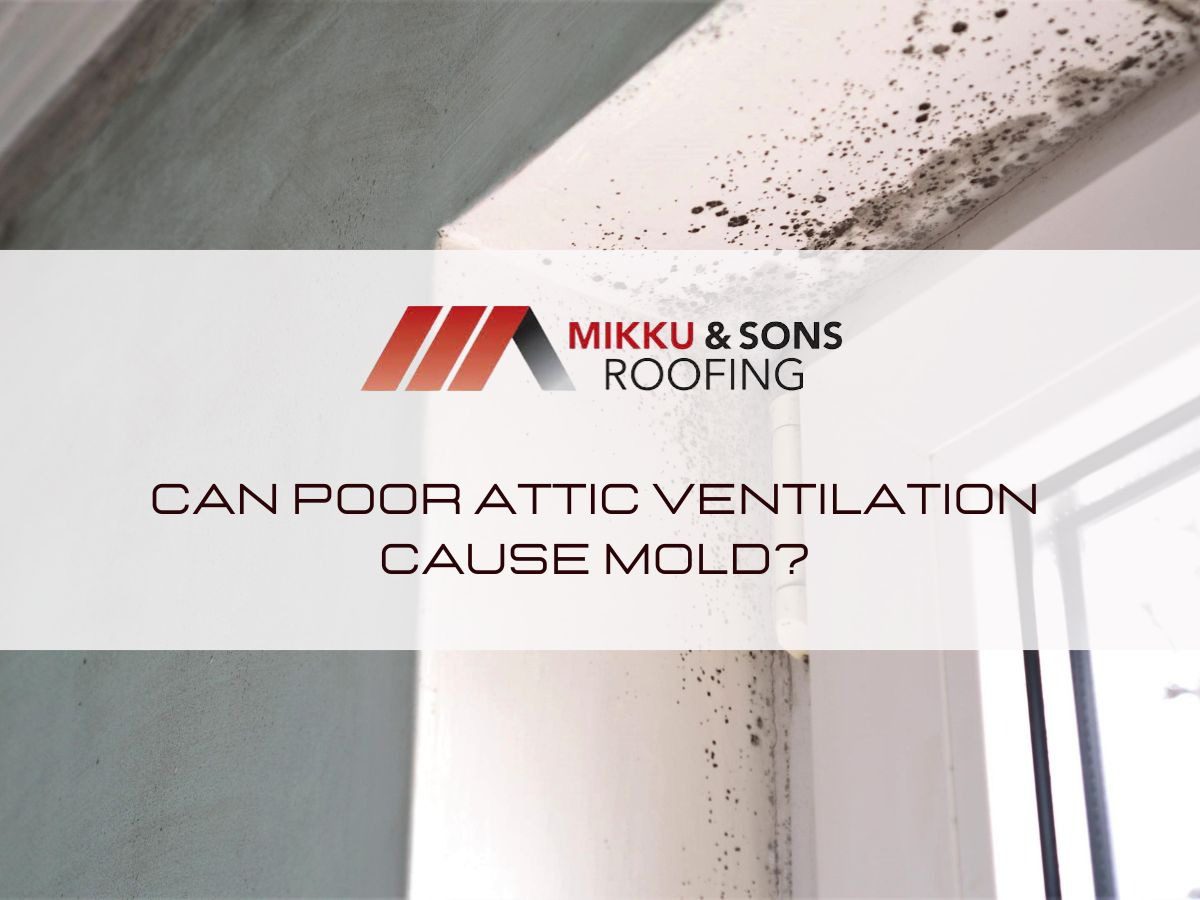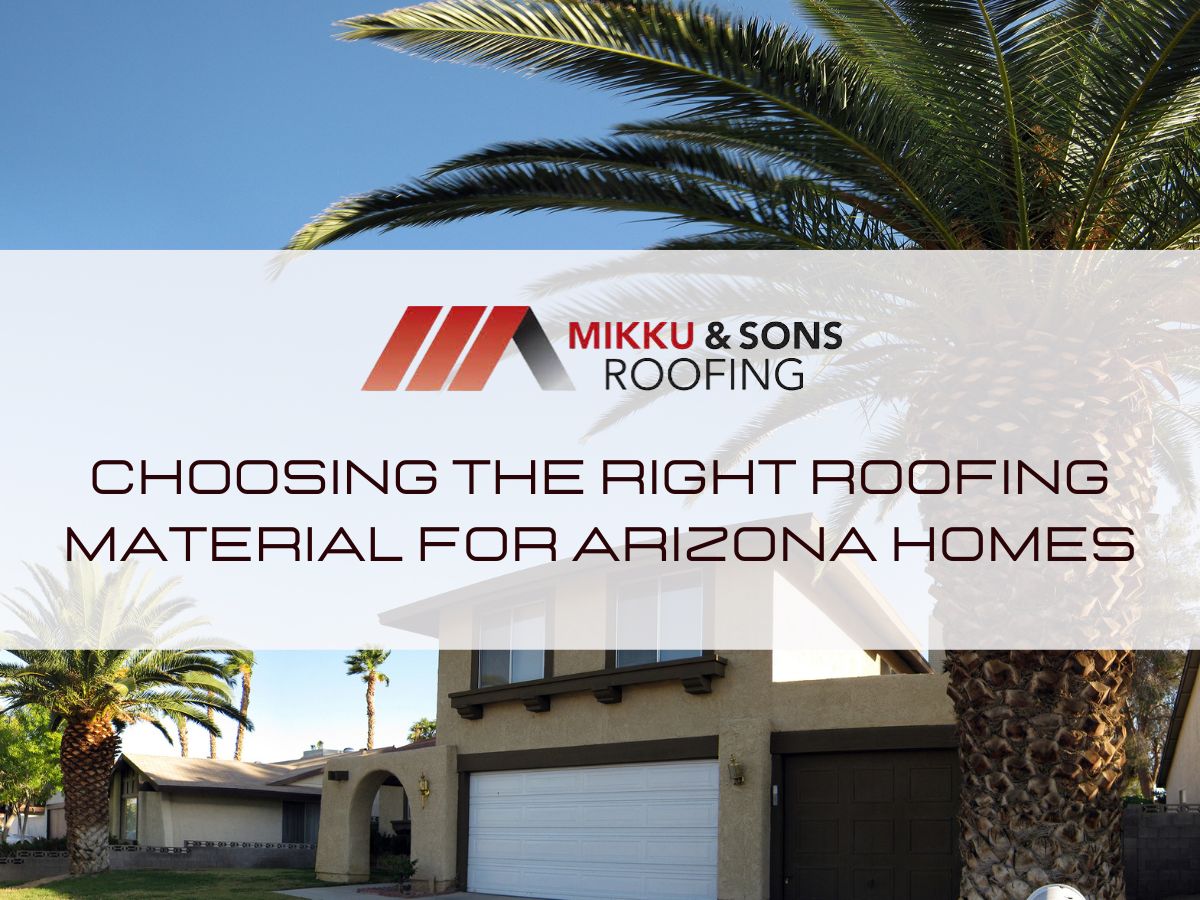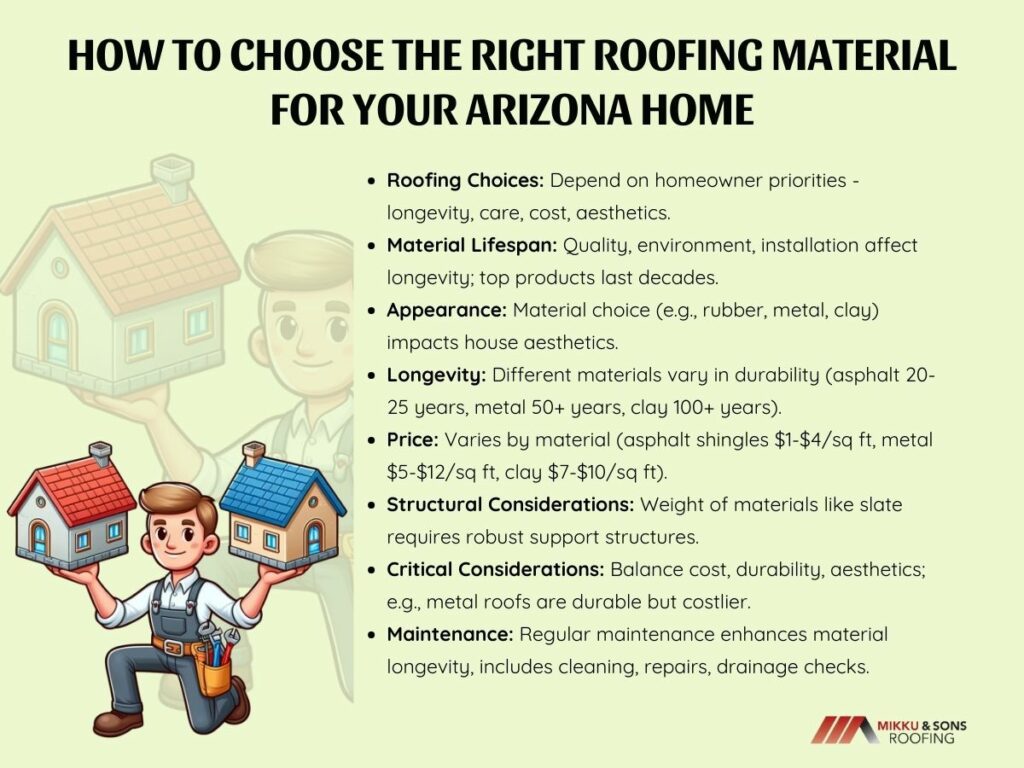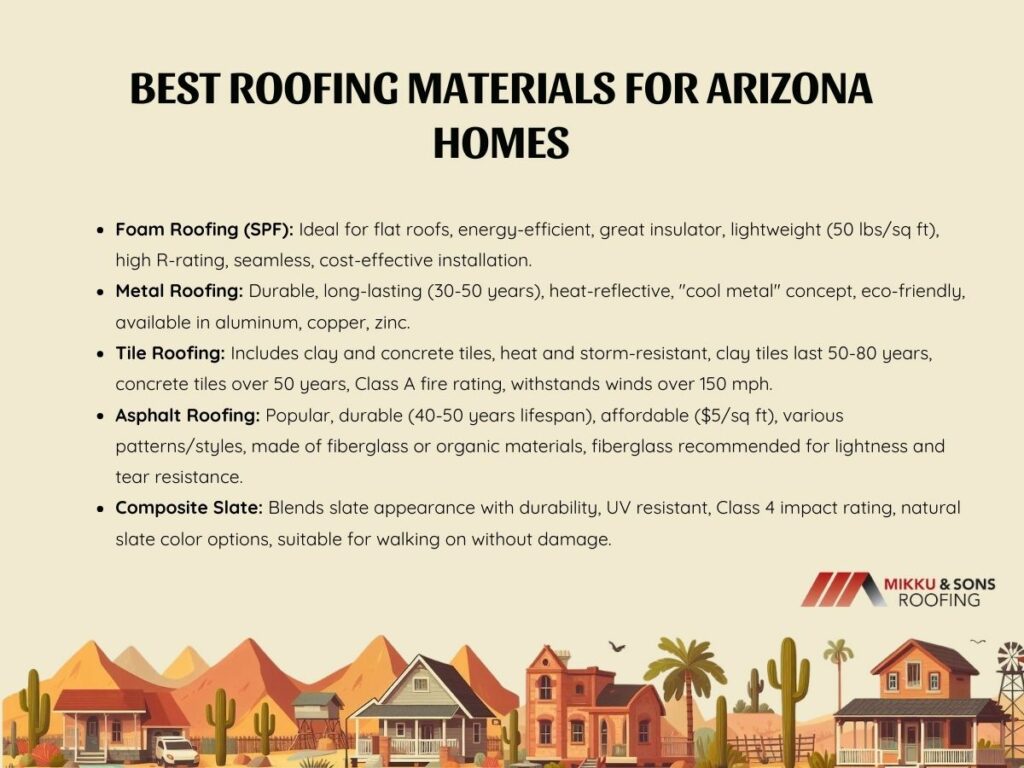

One of the most important things about your Arizona house is the roofing material choice. Along with providing weather protection for you and your possessions, it also significantly improves the overall look and energy efficiency of your house.
In Arizona, extreme weather events such as windstorms, snowfall, fires, or even minor things like ceiling leaks can necessitate new roofs. Arizona has harsh weather all year round, with scorching summers, slightly tolerable winters, surges of rain, occasional hurricanes, etc. Choosing the right roofing material for Arizona homes is essential.
The regular variations in weather can have an impact on your roof's condition. Choosing the correct roofing material for Arizona is crucial because of its hot summers and moderate winters.
The answer genuinely relies on what matters most to each homeowner, be it longevity, simplicity of care, overall installation costs, or aesthetics. In summary, each type of roofing system has benefits, drawbacks, and environmentally friendly aspects.
A number of elements, including the overall design, the quality of the materials, the surrounding environment, and the caliber of the installation, will affect how long your roof lasts. When properly maintained and installed by a trained roofing specialist, today's top roofing products can easily last for decades.

Achieving an appealing look for your roof is a vital part of home design. The visual impression of the roofing materials you choose can enhance or degrade the overall aesthetic appeal of your house.
The appearance of various roofing materials, such as neoprene, EPDM, PVC, chlorinated polyethylene, chlorosulfonated polyethylene sheets, polymer-modified bitumens, and green roof options vary in texture, color shade, style shape, and other features like sheen and translucency. A flat roof appears sleek with rubber roofing membranes or thermoplastic olefin (TPO), whereas metal roofing gives a rustic charm to residential properties.
To achieve optimum results for your home frontage styling while considering other factors such as durability and cost-effectiveness when selecting the appropriate type of roofing material.
The lifespan of a roofing material depends on several factors, such as the quality of the material, proper maintenance, and the environment in which it is installed. Choosing a durable and long-lasting roof can save you money in the long run by reducing repair costs and replacements.
Different types of roofing materials have varying levels of longevity. For instance,
Moreover, other types of roofing materials like wood shingles and shakes or slate tiles may have an extended lifespan but are vulnerable to damage from harsh weather elements such as snow storms or hail storms. In areas where heavy rainfall is common, some roofers recommend rubber tiles because they tend to age well in wet conditions.
The pricing of different types of roof materials is an essential factor in determining the most suitable option for residential roofing. Here are some insights into material price trends for modern roofing materials:
While asphalt shingles provide a relatively affordable option, metal roofing, clay tiles, and concrete tiles tend to cost more. Despite varying prices, it is crucial to make decisions based on the material's durability, energy efficiency, and overall lifespan.
Ensuring that the roof can handle the weight and stress of certain materials is crucial in avoiding potential damage or collapse. Some roofing options, such as slate or ceramic tiles, are heavier than others and require a more robust structure to support them.
On the other hand, lighter options like asphalt shingles may not need as much support but may have a shorter lifespan. It's, therefore, important to consult with experts who can evaluate your home's condition and recommend appropriate roofing material options.
Understanding the critical considerations for a roofing project involves evaluating factors that impact both roof replacement costs and specific needs. For instance, metal roofing, though initially more expensive, proves economical over time due to its durability, reducing the need for frequent replacements, as seen with materials like asphalt.
Furthermore, the aesthetic appeal of clay tiles must be weighed against their weight, brittleness, and delicate nature during installation. In contrast, metal roofs offer durability without compromising on looks.
Cost-effectiveness can be maximized across various roofing materials through diligent maintenance. Simple routines, such as regular cleaning and timely repairs, can prevent further damage to the roofing system, ultimately reducing overall costs.
For instance, performing drainage checks and clearing debris from gutters helps mitigate soil erosion that can harm roofs over time. Investing in proper maintenance practices is a proactive strategy to enhance the longevity of your chosen roofing material.
In Arizona, roofs have to be able to endure intense heat, scorching sun rays, wind, and rain during the monsoon season. A roof may be damaged over the years by extremely hot weather, and as Arizona's climate can fluctuate greatly from hot to cold to hot again, the materials used must be robust, long-lasting, and heat resistant.
Remember that during windy and rainy seasons, inadequate roofing might result in significant water damage. Which roofing types and materials are, therefore, ideal for homes in Arizona?

For flat roofs in Arizona, especially prevalent in commercial properties, Spray Polyurethane Foam (SPF) roofing stands out as the optimal choice. Renowned for its energy efficiency, this roofing type is particularly favored by commercial property owners seeking effective insulation and long-term savings.
The efficiency of SPF roofing is further underscored by its high R-rating of approximately 6.5 per inch, reflecting its exceptional ability to deflect heat and maintain cooler indoor temperatures during the scorching summer months. I
Contrary to preconceptions, metal roofs, available in shingles or panels, can seamlessly integrate into any neighborhood with a modern and sleek appearance. The inherent strength and durability of metal make it a long-lasting option, requiring replacement only after decades of reliable service.
One of the standout features of metal roofing is its ability to redirect heat, contributing to a cooler interior. This enhances comfort and aligns with the concept of "cool metal roofing," potentially reducing long-term energy costs.
Reflecting heat efficiently, metal roofs demonstrate eco-friendly characteristics, providing a dual benefit of sustainability and financial savings. Standing seam metal roofing is a popular option with a functional lifespan of between 30 and 50 years.
It is characterized by steel panels with overlapping seams that form raised ridges along the roof slope. Aluminum is a great material for this style since it is both lightweight and robust. Copper and zinc are other good choices; copper acquires a distinct look as it weathers.
In the arid landscape of Arizona, roofing choices play a critical role in enduring the harsh conditions, with two prominent contenders being concrete and clay tiles. Recognized for their classic charm, clay tiles are a common sight in Arizona homes.
Concrete tiles, another prevalent option, offer a cost-effective alternative with enduring strength. Crafted from a mixture of sand, water, cement, and iron oxide, these tiles undergo molding and heating, resulting in a robust, natural-looking roofing material.
While both concrete and clay tiles share longevity and resistance to the elements, each presents unique characteristics. Clay tiles boast an unmistakable aesthetic appeal, while concrete tiles offer a pragmatic and economical solution.
Choosing between these two materials involves thoughtful consideration of both visual preferences and specific durability requirements, ensuring that your Arizona home stands resilient against the test of time and nature.
Asphalt shingles are a common option, found in 80% of American homes, due to their durability and incredibly low cost ($5 per square foot). The lifespan of asphalt shingles can range from 40 to 50 years, depending on the quality used. However, re-installation is not a big deal because they are reasonably priced.
The fact that shingle roofs are available in a variety of patterns and styles contributes to their appeal. Additionally, there won't be as many options available to you, which makes this roofing quite inviting.
Either organic material or fiberglass is used to make the asphalt shingles. It is advised to choose fiberglass shingles due to their lightweight, ease of installation, and resistance to tearing and damage. Organic shingles, on the other hand, are heavier but provide more stability.
Composite slate emerges as a versatile choice, seamlessly blending the allure of quarried slate with practical advantages. This roofing option marries natural aesthetics with lightweight, durable construction, eliminating the need for costly substructure modifications.
One of the standout features of synthetic slate roofing is its enhanced resistance to the relentless Arizona sun, thanks to the inclusion of UV inhibitors. Moreover, these tiles exhibit a substantial weight-bearing capacity, allowing homeowners to walk on the roof without risking damage.
With a prevalent Class 4 impact rating, composite slate ensures durability against external forces, providing homeowners with peace of mind. Notably, the composite slate market offers a broad spectrum of natural slate colors, allowing for a customized and visually appealing roofing solution.
This innovative material combines the charm of authentic slate with modern engineering, offering an ideal compromise between aesthetics and practicality for Arizona homeowners seeking enduring roofing solutions.
Now that you are more knowledgeable about the best roofing materials in Arizona consult with a roofing expert to help you make an informed choice and get the most out of your new roof in the long run. However, the journey towards a well-protected home doesn't end there.
Armed with the knowledge of choosing the right roofing material, it's equally vital to implement effective ventilation systems. Adequate ventilation not only safeguards your investment by preventing heat-related damages but also enhances energy efficiency within your home.
Transitioning from the importance of roofing materials, it's imperative to recognize the symbiotic relationship between your roof and proper ventilation, as discussed in "The Importance of Proper Roof Ventilation in the Arizona Heat."
